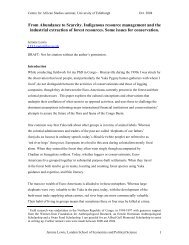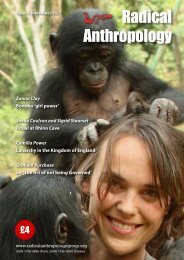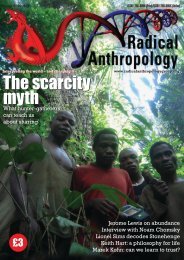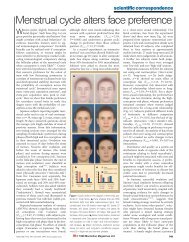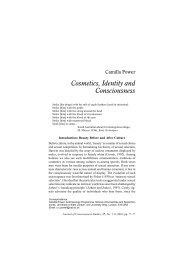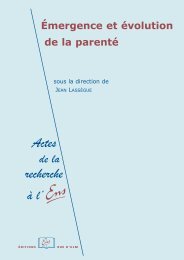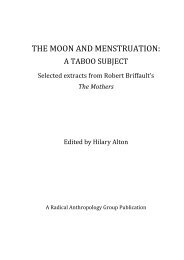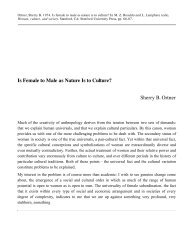Resp<strong>on</strong>se/Locke & Bogin: <str<strong>on</strong>g>Language</str<strong>on</strong>g> <str<strong>on</strong>g>and</str<strong>on</strong>g> <str<strong>on</strong>g>life</str<strong>on</strong>g> <str<strong>on</strong>g>history</str<strong>on</strong>g>particularly to our treatment of <str<strong>on</strong>g>life</str<strong>on</strong>g> <str<strong>on</strong>g>history</str<strong>on</strong>g>, <str<strong>on</strong>g>and</str<strong>on</strong>g> <strong>the</strong>n turnour attenti<strong>on</strong> to replies that pertain more specifically tolanguage.R1. Life <str<strong>on</strong>g>history</str<strong>on</strong>g>Any <strong>the</strong>ory of human biology <str<strong>on</strong>g>and</str<strong>on</strong>g> culture needs to explainhow Homo sapiens successfully combines delayed reproducti<strong>on</strong>,helpless <str<strong>on</strong>g>new</str<strong>on</strong>g>borns, a short durati<strong>on</strong> of breastfeeding,a vastly extended period of offspring dependency,an adolescent growth spurt in both sexes, <str<strong>on</strong>g>and</str<strong>on</strong>g> femalemenopause a decade or more before death. No o<strong>the</strong>rprimate species shares all of <strong>the</strong>se traits. Theory also isneeded to explain <strong>the</strong> extraordinary size of <strong>the</strong> humanbrain, in relati<strong>on</strong> to overall body size, <str<strong>on</strong>g>and</str<strong>on</strong>g> <strong>the</strong> extraordinarycognitive-behavioral abilities of <strong>the</strong> brain, includingsymbolic language, <strong>the</strong>ory of mind, kinship, marriage, religi<strong>on</strong>,<str<strong>on</strong>g>and</str<strong>on</strong>g> even nihilistic philosophy. In our target article,we apply <str<strong>on</strong>g>life</str<strong>on</strong>g> <str<strong>on</strong>g>history</str<strong>on</strong>g> <strong>the</strong>ory in an attempt to better underst<str<strong>on</strong>g>and</str<strong>on</strong>g>human nature regarding growth, <strong>development</strong>, <str<strong>on</strong>g>and</str<strong>on</strong>g>language.One commentator, Weisfeld, denies that human beingshave a unique or unusual <str<strong>on</strong>g>life</str<strong>on</strong>g> <str<strong>on</strong>g>history</str<strong>on</strong>g>; in fact he does notuse <strong>the</strong> phrase “<str<strong>on</strong>g>life</str<strong>on</strong>g> <str<strong>on</strong>g>history</str<strong>on</strong>g>” at all in his commentary. IfWeisfeld’s critique is correct, <strong>the</strong>n <strong>the</strong> whole of our argumentfalls. But, his citati<strong>on</strong>s regarding human <str<strong>on</strong>g>life</str<strong>on</strong>g> <str<strong>on</strong>g>history</str<strong>on</strong>g><str<strong>on</strong>g>and</str<strong>on</strong>g> n<strong>on</strong>human primate growth are both selective <str<strong>on</strong>g>and</str<strong>on</strong>g>somewhat old. The most recent citati<strong>on</strong> is from 1993,well before some of <strong>the</strong> most salient work <strong>on</strong> primate<str<strong>on</strong>g>life</str<strong>on</strong>g> <str<strong>on</strong>g>history</str<strong>on</strong>g> was published. We cite that more recentresearch in our target article, <str<strong>on</strong>g>and</str<strong>on</strong>g> we provide additi<strong>on</strong>alreferences in this resp<strong>on</strong>se (see below). Moreover,Weisfeld’s interpretati<strong>on</strong>s are idiosyncratic, do not reflect<strong>the</strong> broad c<strong>on</strong>sensus of primate <str<strong>on</strong>g>life</str<strong>on</strong>g> <str<strong>on</strong>g>history</str<strong>on</strong>g> researchers, orare incorrect. The studies he cites (also cited by Ragir &Brooks) alleging that all primates have a skeletal, or evena body weight, growth spurt at <strong>the</strong> time of pubertyoriginated in <strong>the</strong> 1950s (Gavan 1953). Gavan’s originalpaper c<strong>on</strong>cludes that chimpanzees (a sample of 9 males<str<strong>on</strong>g>and</str<strong>on</strong>g> 7 females) do not have a pubertal growth spurt.Watts <str<strong>on</strong>g>and</str<strong>on</strong>g> Gavan (1982) reanalyzed <strong>the</strong> 1953 chimpanzeedata, al<strong>on</strong>g with <str<strong>on</strong>g>new</str<strong>on</strong>g> data for <strong>the</strong> rhesus m<strong>on</strong>key, <str<strong>on</strong>g>and</str<strong>on</strong>g>reported that a “very small” positive deviati<strong>on</strong> in b<strong>on</strong>egrowth could be detected at <strong>the</strong> time of puberty. “Verysmall” means less than a 3.0-mm deviati<strong>on</strong>, which occursduring <strong>on</strong>e year, <str<strong>on</strong>g>and</str<strong>on</strong>g> <strong>the</strong> detecti<strong>on</strong> scheme requiredpolynomial regressi<strong>on</strong> fitted to <strong>the</strong> b<strong>on</strong>e growth data.We have criticized <strong>the</strong> methods <str<strong>on</strong>g>and</str<strong>on</strong>g> statistics needed toshow <strong>the</strong>se “spurts” (Bogin 1999a; 1999b). The humanadolescent growth spurt is measured in centimeters –with a mean peak velocity of about 7.5 cm per year forgirls <str<strong>on</strong>g>and</str<strong>on</strong>g> 9.0 cm per year for boys. The human spurttakes about eight years to complete. Leigh (1996; 2001)shows that, am<strong>on</strong>g 61 primate species, weight growthspurts vary greatly in magnitude <str<strong>on</strong>g>and</str<strong>on</strong>g> even in <strong>the</strong>ir existence– <strong>on</strong>ly <strong>on</strong>e species of New World m<strong>on</strong>key may have aweight spurt; gibb<strong>on</strong>s do not, <str<strong>on</strong>g>and</str<strong>on</strong>g> <strong>on</strong>ly males of <strong>the</strong>comm<strong>on</strong> chimpanzee do. Leigh could not c<strong>on</strong>firm thatany n<strong>on</strong>human primate species has a skeletal growthspurt. Hamada <str<strong>on</strong>g>and</str<strong>on</strong>g> Ud<strong>on</strong>o (2002) published <strong>the</strong> first statisticallysound <str<strong>on</strong>g>and</str<strong>on</strong>g> methodologically rigorous l<strong>on</strong>gitudinalstudy of chimpanzee skeletal growth. They found thatchimpanzees reared within semi-natural social c<strong>on</strong>diti<strong>on</strong>sat a zoological park in Japan show no increase in l<strong>on</strong>gb<strong>on</strong>e growth velocity at <strong>the</strong> time of puberty (Fig. R1).In c<strong>on</strong>trast, chimpanzees used in medical research, whowere taken out of <strong>the</strong>ir social groups prior to puberty,stopped or greatly slowed growth during <strong>the</strong> time of experimentati<strong>on</strong>.When returned to <strong>the</strong>ir social group afterexperimentati<strong>on</strong> <strong>the</strong>se chimpanzees experienced rapidgrowth, imitating a growth spurt. But this is not at allsimilar to <strong>the</strong> human adolescent growth spurt. Ra<strong>the</strong>r,Hamada <str<strong>on</strong>g>and</str<strong>on</strong>g> Ud<strong>on</strong>o (2002) explain that it is a type of“catch-up” growth following <strong>the</strong> stress of social separati<strong>on</strong><str<strong>on</strong>g>and</str<strong>on</strong>g> medical experimentati<strong>on</strong>. Human beings show thisFigure R1. Model of distance (left) <str<strong>on</strong>g>and</str<strong>on</strong>g> velocity (right) curves for chimpanzee growth in body length by years of age. Data for <strong>the</strong>figure come from <strong>the</strong> l<strong>on</strong>gitudinal study of captive chimpanzee growth c<strong>on</strong>ducted by Hamada <str<strong>on</strong>g>and</str<strong>on</strong>g> Ud<strong>on</strong>o (2002). The infancy,juvenile, <str<strong>on</strong>g>and</str<strong>on</strong>g> mature adult <str<strong>on</strong>g>life</str<strong>on</strong>g> stages are labeled. In <strong>the</strong> wild, weaning (W) usually takes place between 48–60 m<strong>on</strong>ths of age(Pusey 1983). In captivity, female puberty (P), assessed by age at first maximal perineal swelling, takes place at a mean age of 7.95years (Littlet<strong>on</strong> 2005).302 BEHAVIORAL AND BRAIN SCIENCES (2006) 29:3
Resp<strong>on</strong>se/Locke & Bogin: <str<strong>on</strong>g>Language</str<strong>on</strong>g> <str<strong>on</strong>g>and</str<strong>on</strong>g> <str<strong>on</strong>g>life</str<strong>on</strong>g> <str<strong>on</strong>g>history</str<strong>on</strong>g>type of “catch-up” growth following chr<strong>on</strong>ic illness, nutriti<strong>on</strong>aldeprivati<strong>on</strong>, or severe emoti<strong>on</strong>al distress (Bogin1999b; Prader et al. 1963).Finally, Weisfeld writes that we should not ab<str<strong>on</strong>g>and</str<strong>on</strong>g><strong>on</strong> <strong>the</strong>c<strong>on</strong>venti<strong>on</strong> of using <strong>the</strong> term “adolescence” to apply tosimians. He states, “What would we o<strong>the</strong>rwise call <strong>the</strong>period of puberty in simians?” How about “puberty”?Indeed, primate puberty is a neuroendocrine event of relativeshort durati<strong>on</strong>, taking place in <strong>the</strong> brain (Plant &Barker-Gibb 2004). Human adolescence follows thisevent, lasts for eight years, <str<strong>on</strong>g>and</str<strong>on</strong>g> involves ritual behaviorsthat instruct <strong>the</strong> youth in ec<strong>on</strong>omic, sexual, <str<strong>on</strong>g>and</str<strong>on</strong>g> politicalbehavior, <str<strong>on</strong>g>and</str<strong>on</strong>g> eventually transform <strong>the</strong> youth into asocially acceptable adult ready for marriage <str<strong>on</strong>g>and</str<strong>on</strong>g> parenthood.No o<strong>the</strong>r species comes close to this biological,behavioral, <str<strong>on</strong>g>and</str<strong>on</strong>g> cultural stage of <str<strong>on</strong>g>life</str<strong>on</strong>g> <str<strong>on</strong>g>history</str<strong>on</strong>g>.Eckhardt’s comments remind us that <strong>the</strong> homininlineage split off from o<strong>the</strong>r primates at least 6 milli<strong>on</strong>years ago. There is no evidence that chimpanzees, as weknow <strong>the</strong>m today, even existed at that time (McBrearty& Jabl<strong>on</strong>ski 2005). That chimpanzees knuckle-walk <str<strong>on</strong>g>and</str<strong>on</strong>g>humans have childhood <str<strong>on</strong>g>and</str<strong>on</strong>g> adolescence merely reflects<strong>the</strong>ir independent evoluti<strong>on</strong> <str<strong>on</strong>g>and</str<strong>on</strong>g> adaptati<strong>on</strong> to differentecologies. Despite this separati<strong>on</strong> in time, King makes avery good point about c<strong>on</strong>tinuities between primatespecies in many aspects of communicati<strong>on</strong> <str<strong>on</strong>g>and</str<strong>on</strong>g> social interacti<strong>on</strong>.The disc<strong>on</strong>tinuity, we believe, is <strong>the</strong> humancapacity for emoti<strong>on</strong>al engagement between multiplecaretakers <str<strong>on</strong>g>and</str<strong>on</strong>g> dependent young that is clearly different.A few of <strong>the</strong> commentaries <strong>on</strong> our article seem to have adifferent noti<strong>on</strong> of <str<strong>on</strong>g>life</str<strong>on</strong>g> <str<strong>on</strong>g>history</str<strong>on</strong>g> <str<strong>on</strong>g>and</str<strong>on</strong>g> <str<strong>on</strong>g>life</str<strong>on</strong>g> <str<strong>on</strong>g>history</str<strong>on</strong>g> <strong>the</strong>ory thanwe do (e.g., Bickert<strong>on</strong>; Dickins; Ragir & Brooks).O<strong>the</strong>rs, including Gogate, Kappeler, <str<strong>on</strong>g>and</str<strong>on</strong>g> Oller &Griebel, have expressed legitimate differences ofopini<strong>on</strong> with our model of human <str<strong>on</strong>g>life</str<strong>on</strong>g> <str<strong>on</strong>g>history</str<strong>on</strong>g>. Let usaddress <strong>the</strong>ir comments with a clear definiti<strong>on</strong> of ourterms. Life <str<strong>on</strong>g>history</str<strong>on</strong>g> may be defined as <strong>the</strong> strategy anorganism uses to allocate its energy toward growth, maintenance,reproducti<strong>on</strong>, raising offspring to independence,<str<strong>on</strong>g>and</str<strong>on</strong>g> avoiding death. For a mammal, it is <strong>the</strong> strategy ofwhen to be born, when to be weaned, how many <str<strong>on</strong>g>and</str<strong>on</strong>g>what type of pre-reproductive stages of <strong>development</strong> topass through, when to reproduce, <str<strong>on</strong>g>and</str<strong>on</strong>g> when to die(Bogin & Smith 1996). Life <str<strong>on</strong>g>history</str<strong>on</strong>g>, in this definiti<strong>on</strong>,encompasses <strong>the</strong> major growth, <strong>development</strong>, <str<strong>on</strong>g>and</str<strong>on</strong>g> reproductiveevents that occur between <strong>the</strong> c<strong>on</strong>cepti<strong>on</strong> <str<strong>on</strong>g>and</str<strong>on</strong>g>death of an organism.Living things <strong>on</strong> earth have greatly different <str<strong>on</strong>g>life</str<strong>on</strong>g> <str<strong>on</strong>g>history</str<strong>on</strong>g>strategies <str<strong>on</strong>g>and</str<strong>on</strong>g> <str<strong>on</strong>g>life</str<strong>on</strong>g> <str<strong>on</strong>g>history</str<strong>on</strong>g> stages – c<strong>on</strong>sider those insectswith more than a dozen stages from c<strong>on</strong>cepti<strong>on</strong> to reproductiveadult. The differences in <str<strong>on</strong>g>life</str<strong>on</strong>g> <str<strong>on</strong>g>history</str<strong>on</strong>g> characteristicscan have profound effects in several biological domains,including growth dynamics, ecology, demography, behavior,<str<strong>on</strong>g>and</str<strong>on</strong>g> evoluti<strong>on</strong> of populati<strong>on</strong>s. Life <str<strong>on</strong>g>history</str<strong>on</strong>g> <strong>the</strong>ory,which is <strong>the</strong> scientific study of <str<strong>on</strong>g>life</str<strong>on</strong>g>-cycle strategies <str<strong>on</strong>g>and</str<strong>on</strong>g><strong>the</strong>ir evoluti<strong>on</strong>, provides a way to unify systematic researchin <strong>the</strong> many separate domains, each studied by differentgroups of specialists. One of <strong>the</strong> best introducti<strong>on</strong>s tocurrent <str<strong>on</strong>g>life</str<strong>on</strong>g> <str<strong>on</strong>g>history</str<strong>on</strong>g> <strong>the</strong>ory is provided by Stearns (1992).Part of <strong>the</strong> focus of our article links <strong>the</strong> way in whichpeople grow <str<strong>on</strong>g>and</str<strong>on</strong>g> develop with human reproductivesuccess, which is greater than that of any o<strong>the</strong>r mammal.The social mammals, such as wolves, li<strong>on</strong>s, <str<strong>on</strong>g>and</str<strong>on</strong>g> elephants,rear about 12–18% of <strong>the</strong>ir live-born offspring toadulthood. Our closest living relative, <strong>the</strong> chimpanzee,rears about 36% of its live-born offspring to maturity.But human hunter-ga<strong>the</strong>rers <str<strong>on</strong>g>and</str<strong>on</strong>g> horticulturists, living intraditi<strong>on</strong>al societies without <strong>the</strong> benefits of modernmedical care, rear about 60% of <strong>the</strong>ir infants to adulthood.Industrial societies of North America <str<strong>on</strong>g>and</str<strong>on</strong>g> Western Europesuccessfully rear at least 95% of live-born infants to maturity(Bogin 2001). Some of <strong>the</strong> reas<strong>on</strong>s for this amazinghuman reproductive success are short birth intervals dueto early weaning, <strong>the</strong> evoluti<strong>on</strong> of <strong>the</strong> childhood stage of<strong>development</strong>, <str<strong>on</strong>g>and</str<strong>on</strong>g> human capital-building during <strong>the</strong>juvenile stage <str<strong>on</strong>g>and</str<strong>on</strong>g> <strong>the</strong> uniquely human adolescent stageof <strong>development</strong> (Kaplan et al. 2000). Despite <strong>the</strong> delayin first reproducti<strong>on</strong> produced by <strong>the</strong> inserti<strong>on</strong> of adolescence,primiparous human mo<strong>the</strong>rs are physically,socially, <str<strong>on</strong>g>and</str<strong>on</strong>g> emoti<strong>on</strong>ally better prepared than o<strong>the</strong>rprimate females. This may be seen in <strong>the</strong> mortality ratesfor infants, which are lower for humans than any o<strong>the</strong>rmammalian species (Bogin 1999b).Perhaps <strong>the</strong> most important attribute leading to reproductivesuccess is human cooperative breeding. By thiswe mean <strong>the</strong> cooperative childcare <str<strong>on</strong>g>and</str<strong>on</strong>g> feeding by n<strong>on</strong>maternalkin <str<strong>on</strong>g>and</str<strong>on</strong>g> n<strong>on</strong>-kin that is essential to ensure <strong>the</strong>survival of a weaned child. Cooperative breeding hasevolved independently in several species of mammals,birds, <str<strong>on</strong>g>and</str<strong>on</strong>g> insects. In those species, <str<strong>on</strong>g>and</str<strong>on</strong>g> in many but notall human groups, <strong>the</strong> helpers are close genetic relativesof <strong>the</strong> mo<strong>the</strong>r (Clutt<strong>on</strong>-Brock 2002). By assisting <strong>the</strong>mo<strong>the</strong>r to care for her offspring, <strong>the</strong> helpers increase<strong>the</strong>ir own inclusive fitness, meaning that <strong>the</strong>y increase<strong>the</strong> chances that <strong>the</strong>ir genetic kin will survive to reproductiveage (Hawkes et al. 1998; Paine & Hawkes 2006).Unlike o<strong>the</strong>r species, human societies define kinshiprelati<strong>on</strong>s <strong>on</strong> <strong>the</strong> basis of social as well as genetic ties. In traditi<strong>on</strong>alhuman societies, kinship is <strong>the</strong> central organizingprinciple for ec<strong>on</strong>omic producti<strong>on</strong>, social organizati<strong>on</strong>,<str<strong>on</strong>g>and</str<strong>on</strong>g> ideology. Human cooperative breeding, <strong>the</strong>refore,enhances <strong>the</strong> social, ec<strong>on</strong>omic, political, religious, <str<strong>on</strong>g>and</str<strong>on</strong>g>cultural “fitness” of <strong>the</strong> group as much or more than itc<strong>on</strong>tributes to genetic fitness.We agree with Gogate’s reference to Dynamic SystemsTheory (DST), according to which causality should not beviewed as a linear sequence since <strong>the</strong> emergence of <str<strong>on</strong>g>new</str<strong>on</strong>g>systems is usually <strong>the</strong> result of interacti<strong>on</strong>s of manyfactors at multiple levels. Gogate makes two o<strong>the</strong>r pointsabout DST, <str<strong>on</strong>g>life</str<strong>on</strong>g> <str<strong>on</strong>g>history</str<strong>on</strong>g>, <str<strong>on</strong>g>and</str<strong>on</strong>g> language – namely, thatchange is not predetermined, <str<strong>on</strong>g>and</str<strong>on</strong>g> that change is drivenby instabilities within <strong>the</strong> system. We think that <strong>the</strong>seaspects of DST <str<strong>on</strong>g>and</str<strong>on</strong>g> evoluti<strong>on</strong> help explain disc<strong>on</strong>tinuitiesin <strong>the</strong> biology <str<strong>on</strong>g>and</str<strong>on</strong>g> behavior of closely related species suchas chimpanzees <str<strong>on</strong>g>and</str<strong>on</strong>g> people.The c<strong>on</strong>cept <str<strong>on</strong>g>and</str<strong>on</strong>g> stark reality of biological costs <str<strong>on</strong>g>and</str<strong>on</strong>g>trade-offs are also part of <str<strong>on</strong>g>life</str<strong>on</strong>g> <str<strong>on</strong>g>history</str<strong>on</strong>g> <strong>the</strong>ory. Knight &Power state that we do not c<strong>on</strong>sider biological costs inour article, but we do use <strong>the</strong> word “cost” or “costly”four times in both a biological <str<strong>on</strong>g>and</str<strong>on</strong>g> a social sense (alsosee sect. R9 of this Resp<strong>on</strong>se). For some reas<strong>on</strong>, wefailed to use <strong>the</strong> term “trade-off” <str<strong>on</strong>g>and</str<strong>on</strong>g> that is a serious omissi<strong>on</strong>in any article <strong>on</strong> <str<strong>on</strong>g>life</str<strong>on</strong>g> <str<strong>on</strong>g>history</str<strong>on</strong>g> evoluti<strong>on</strong>. A trade-off maybe thought of as <strong>the</strong> competiti<strong>on</strong> between two biological orbehavioral traits. Stearns says that “trade-offs occur whentwo traits compete for materials <str<strong>on</strong>g>and</str<strong>on</strong>g> energy within a singleorganism” or, “when selecti<strong>on</strong> for <strong>on</strong>e trait decreases <strong>the</strong>value of a sec<strong>on</strong>d trait” (1992, p. 223). An example of <strong>the</strong>BEHAVIORAL AND BRAIN SCIENCES (2006) 29:3 303



